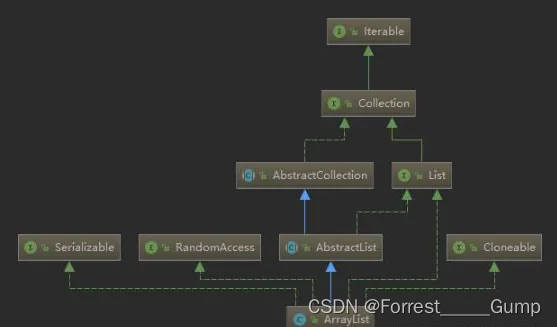ArrayList和LinkedList区别
发布时间:2023年12月17日
目录
一、性质不同
1、arraylist:ArrayList就是动态数组,用MSDN中的说法,就是Array的复杂版本。
2、linkedlist:LinkedList?是一个继承于AbstractSequentialList的双向链表。
二、作用不同
1、arraylist:提供了动态的增加和减少元素,实现了ICollection和IList接口,灵活的设置数组的大小等好处。
2、linkedlist:LinkedList?实现了Cloneable接口,即覆盖了函数clone(),能克隆;LinkedList?实现java.io.Serializable接口,这意味着LinkedList支持序列化,能通过序列化去传输。

三、特点不同
1、arraylist:每个 ArrayList 实例都有一个容量。该容量是指用来存储列表元素的数组的大小。它总是至少等于列表的大小。随着向 ArrayList 中不断添加元素,其容量也自动增长。并未指定增长策略的细节,因为这不只是添加元素会带来分摊固定时间开销那样简单
2、linkedlist:AbstractSequentialList?实现了get(int index)、set(int index, E element)、add(int index, E element) 和 remove(int index)这些骨干性函数。降低了List接口的复杂度。这些接口都是随机访问List的,LinkedList是双向链表;既然它继承于AbstractSequentialList,就相当于已经实现了“get(int index)这些接口”。
文章来源:https://blog.csdn.net/Forrest_____Gump/article/details/135029184
本文来自互联网用户投稿,该文观点仅代表作者本人,不代表本站立场。本站仅提供信息存储空间服务,不拥有所有权,不承担相关法律责任。 如若内容造成侵权/违法违规/事实不符,请联系我的编程经验分享网邮箱:chenni525@qq.com进行投诉反馈,一经查实,立即删除!
本文来自互联网用户投稿,该文观点仅代表作者本人,不代表本站立场。本站仅提供信息存储空间服务,不拥有所有权,不承担相关法律责任。 如若内容造成侵权/违法违规/事实不符,请联系我的编程经验分享网邮箱:chenni525@qq.com进行投诉反馈,一经查实,立即删除!
最新文章
- Python教程
- 深入理解 MySQL 中的 HAVING 关键字和聚合函数
- Qt之QChar编码(1)
- MyBatis入门基础篇
- 用Python脚本实现FFmpeg批量转换
- 贪心算法高频问题-区间问题
- React格式化规范
- 计算机毕业设计 SpringBoot的企业内管信息化系统 Javaweb项目 Java实战项目 前后端分离 文档报告 代码讲解 安装调试
- C++系列十四:结构体
- MySQL的内部XA的二阶段提交
- 腾讯首席技术架构教你从C语言过渡到C++,真的很实用!
- win10 任务栏设置透明
- vim编辑器
- 【docker笔记】Docker容器数据卷
- 抖店只做商品卡流量不容易出单?玩法解析,不要挑战概率就行了